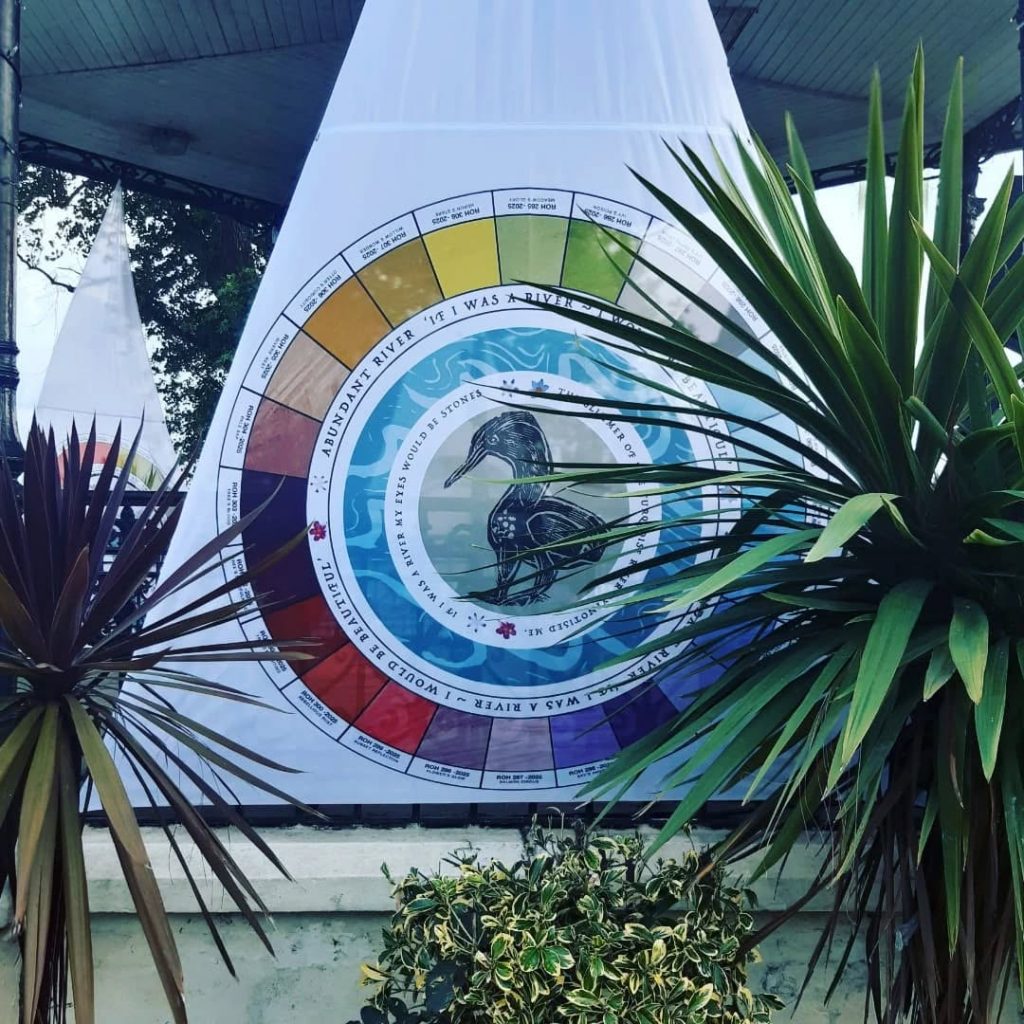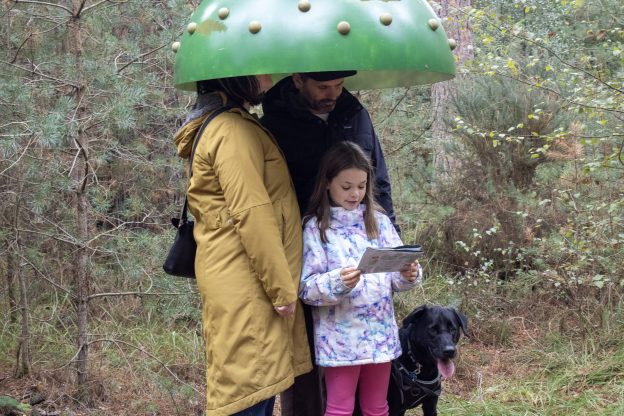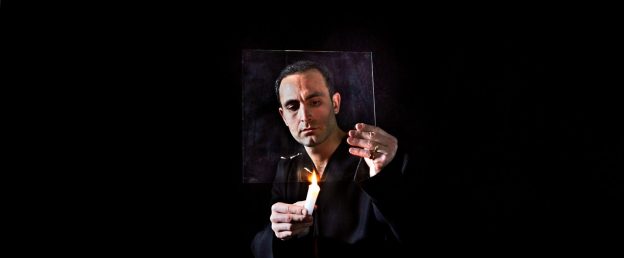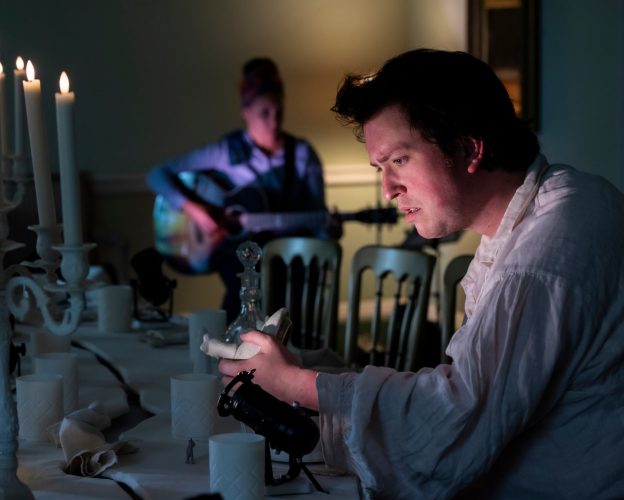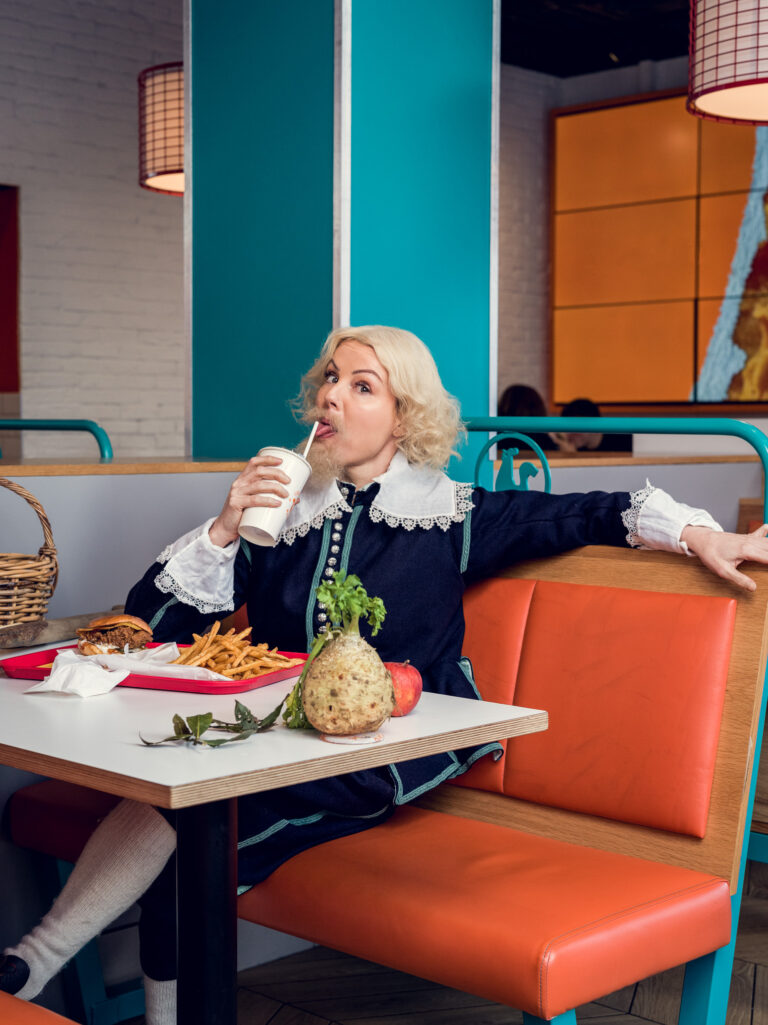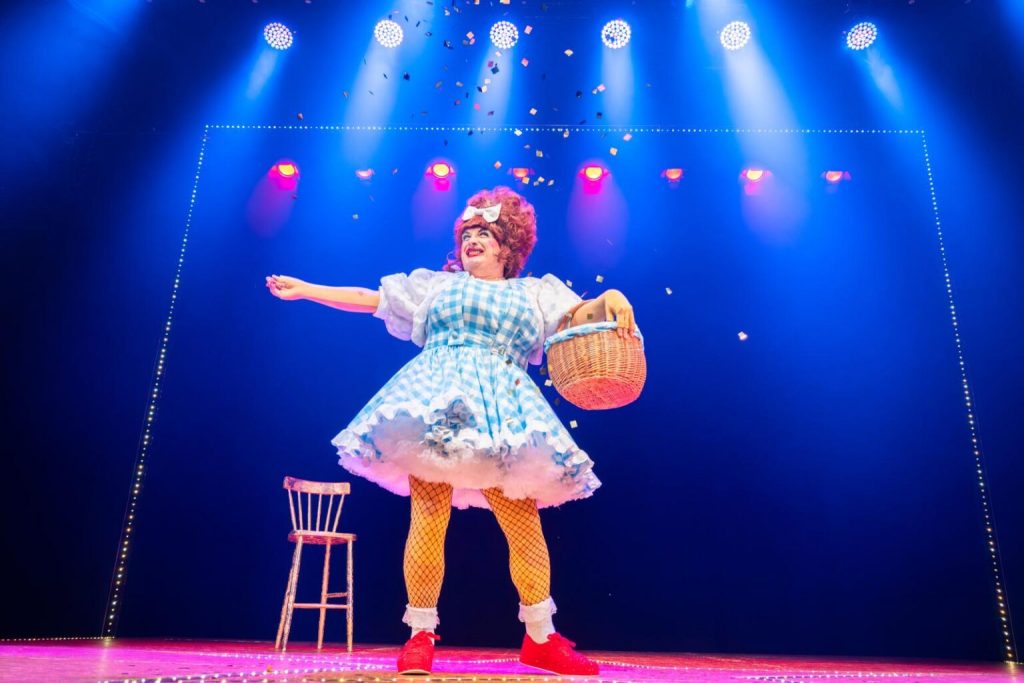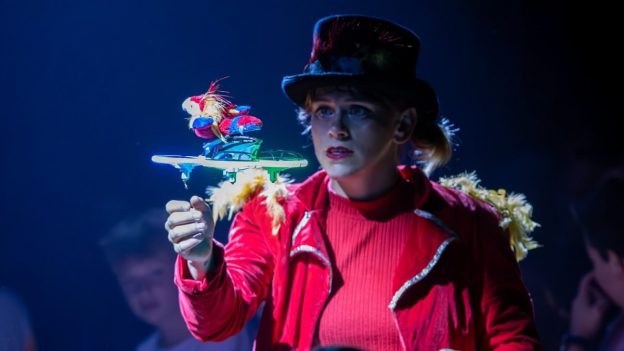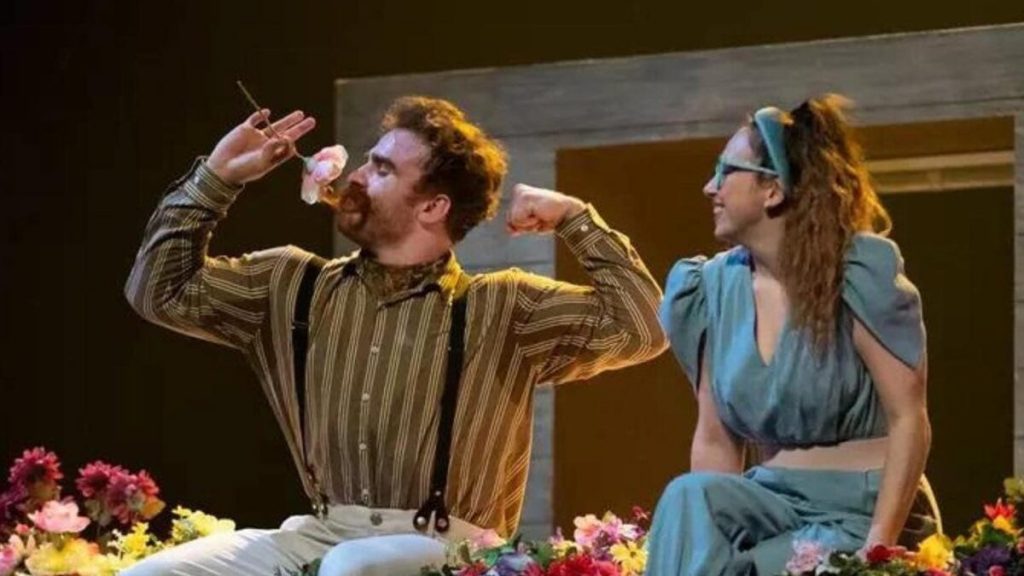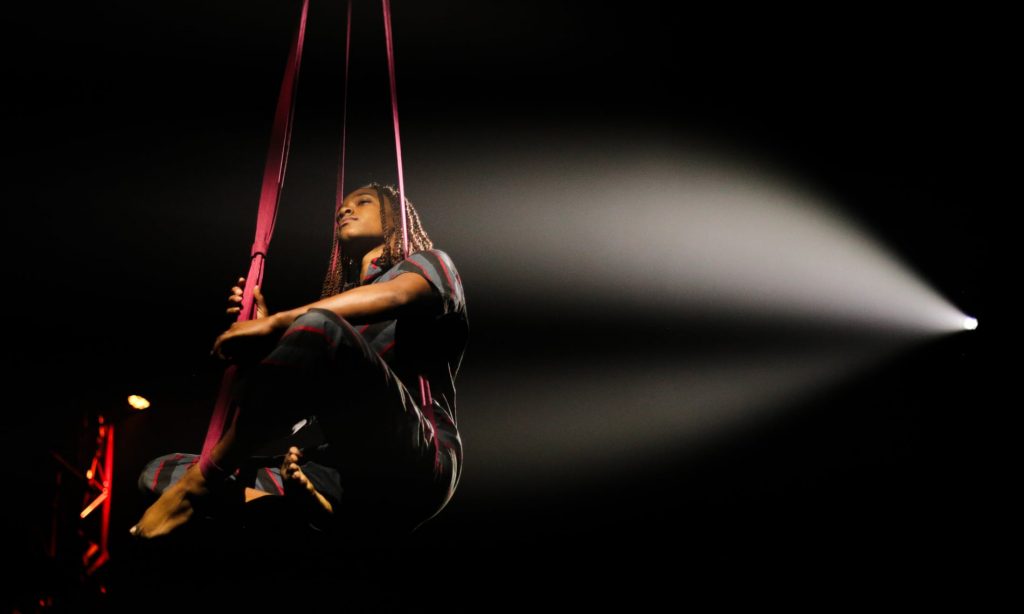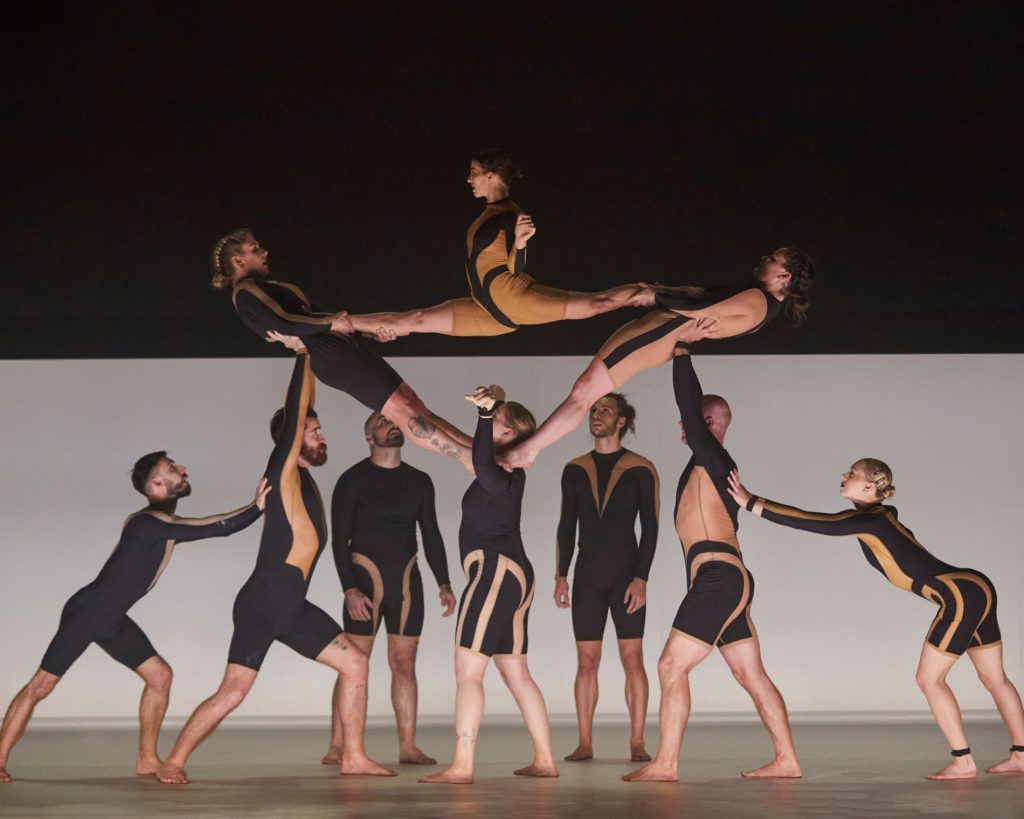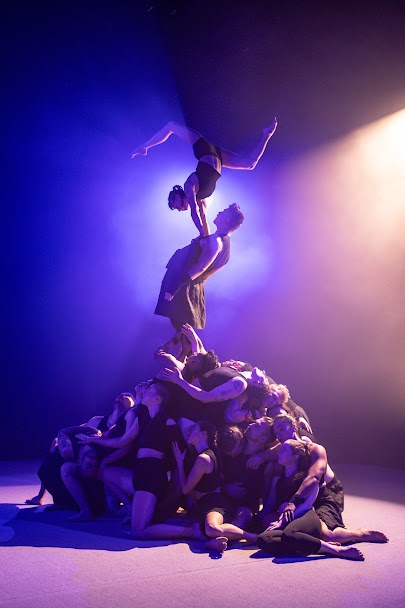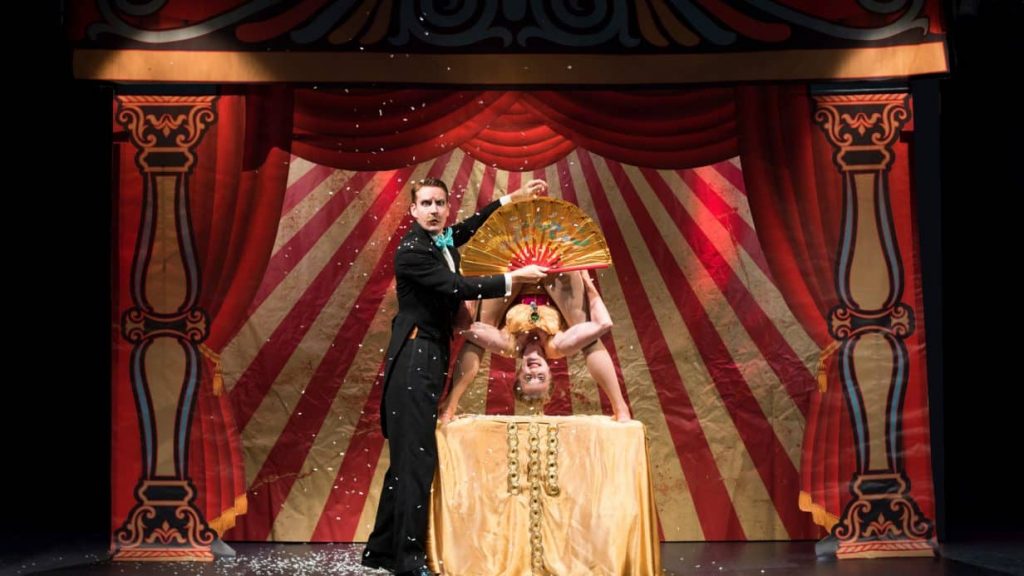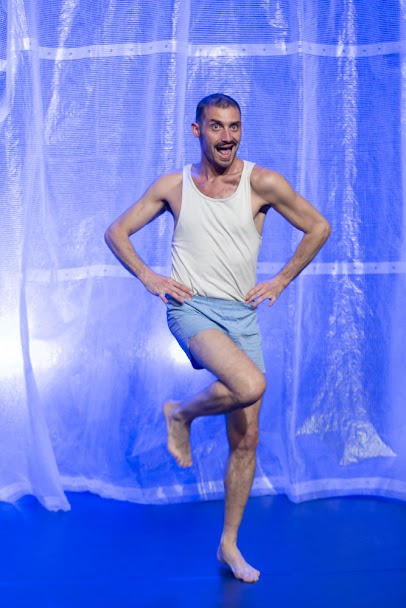Yew trees, giants, wassailing, and witches’ lore. The Inside Out Festival 2025 stretches across Dorset and beyond, and digs deep into the county’s folklore and landscape to bring great works of outdoor arts to life. Dorothy Max Prior reports
Arriving to the quayside at Christchurch on a breezy late-summer Friday evening, I see that there are flags everywhere, fluttering madly.
No, not Union flags or St George flags, but 60 beautifully-designed multi-coloured flags depicting birds, butterflies, fish, flowers, and humanoid figures composed of a multitude of faces. Some are very clean-cut and graphic; some bear texts in cut-out lettering; some are quite abstracted, so that the colours and patterns become more immediate than the figures depicted. Collectively, all seem to convey the message that we are one united world, animal vegetable and mineral – the natural world bearing no regard to political boundaries of state or allegiance.
This is River of Hope, created by artist Heidi Steller and poet Matt West who, inspired by three local rivers – the Stour, the Avon and the Allen – have worked with local young people to respond to those rivers with poetry and visual imagery. The Christchurch iteration of River of Hope, presented as part of the Inside Out Festival 2025, is the culmination of a project run by Thames Festival Trust, which has taken place in seven UK locations; the programme focusing on young people’s reflections on climate change, with concurrent projects taking place in France and Ethiopia.
Immediately before the outing to see the installation, there is a reception to launch this year’s Inside Out Festival, held in a lovely garden that is rather bizarrely populated by models of dinosaurs – a kind of miniature Crystal Palace Park! Here, we gather to drink Pimms; to listen to teenage rapper DJ Lola, whose song ‘What’s the Dream?’ celebrates love and optimism; and to hear co-directors Bill Gee and Kate Wood speak.
Bill notes that it is twenty years since he and Kate first started the conversation about what would become the inaugural Inside Out Festival, founded 18 years ago as a biennial event. He highlighted the international aspects of the Festival, which this year has a strong Catalonian contingent included in the programme; and also flags up (excuse the pun) the three national projects that had a Dorset iteration: River of Hope, Nature Calling, and Beach of Dreams (this last another flag-creating project that I saw last May at Out There Festival in Great Yarmouth, now heading to Corfe Castle for its Inside Out iteration).
For her part, Kate reminds us of Activate’s motto, which is that ‘anything’s possible and everyone’s invited’ telling us that the organisation’s aim is to break down barriers and reach the widest possible audiences, connecting people to the arts whilst celebrating Dorset’s natural landscape.
Speeches done, Pimms drunk, it’s time to head of down to the quay, just a short walk away…
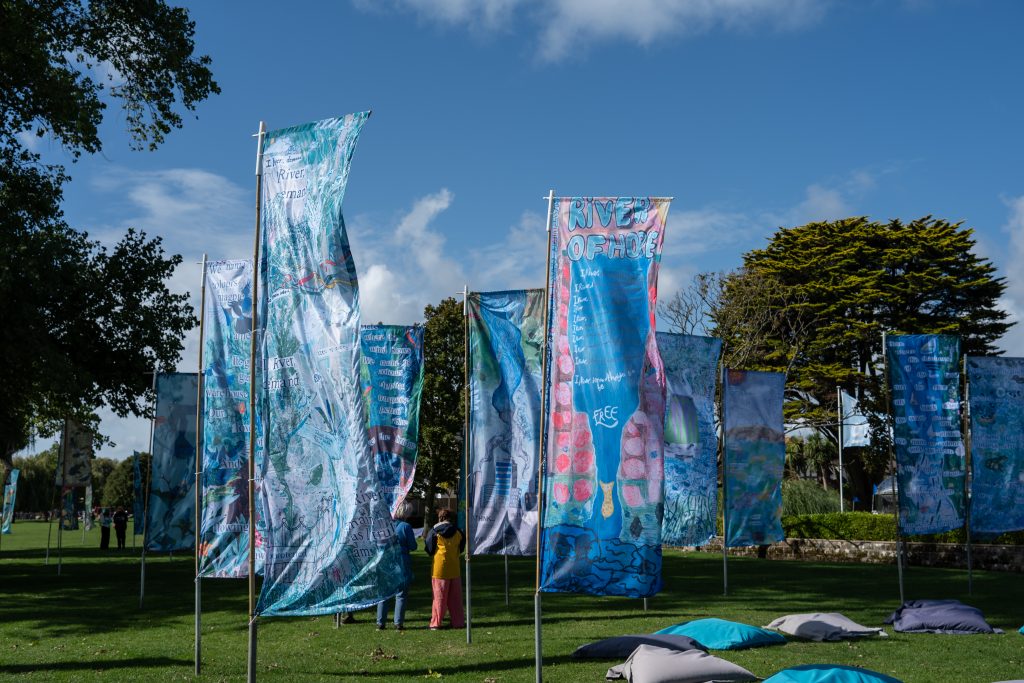
The following morning my companions and I gather at breakfast to compare notes on the storm that raged through the night – which I somehow managed to sleep through. The ground is damp and it is still a little windy, but gathering raincoats and sturdy boots, we set off to Moors Valley Country Park and Forest for the opening day of Canopy: 24 ideas about trees, the brand new immersive sound-work from Lorna Rees (of Gobbledegook Theatre), in which the audience is invited to follow a trail though the forest where we will encounter twenty-four ‘pods’, each housing its own sound world. We arrive dead on 10am, the start time, and the production team are just putting the final touches in place. Luckily nothing has been damaged by the night’s rain and wind, and we are all set to start.
In previous commissions for Inside Out, Lorna has given us artistic explorations of, and guides to, rock forms and to clouds. Now she has turned her attention to trees, working with arborists, earth scientists, artists, writers, folk musicians, and members of the local community.
‘The work is actually about seven years in the making,’ says Lorna. ‘I realised that I very much love trees, but don’t know much about them, even some of the basic identification knowledge. I’m really good at identifying clouds and not too shabby at rocks, but living things have really eluded me. As an environmentalist I wanted to know more about the science of trees, and their role in our planet and ecosystems. I always start my making process with a notion and Canopy was inspired by the idea of who a British forest is for, and what our psycho-geographical forests are. There was just so much to say! I realised that I wanted a collective of voices – different perspectives and communities to respond with their ideas about trees. All of these perspectives and ideas go through my curatorial lens, and some conversations became songs instead of people just talking to me.’
So, what’s the end result? We head off to find out. We are given a map and invited to follow a trail though the forest to discover and experience these 24 different ‘pods’ of various colours and sizes, each suspended in the forest.
‘I’ve worked with some amazing folk to create the pods themselves,’ says Lorna. ‘Liam O’Brien is a product designer and forager, and Amanda Moore is an artist and architect, and together we’ve worked on the special design universe of Canopy, one of slime moulds and fungus and seeds. We’ve worked really hard to be as environmentally careful as possible, and to work with people who really make things. The sonic acorns in the domes [that deliver the soundscapes] were specially made in Birmingham by a team of craftsmen, out of beech and oak. And artist and designer Sophie Fretwell has collaborated with me on costume and design. I love fungi and slime moulds and the seed pods – the idea was to look retro-futuristic – slightly sci-fi – but also to be clearly of the place it’s sprung from’.

In the very first pod, artist, philosopher and clown (great combination, that!) Remi Oriogun-Williams tackles the key issue: ‘What is a Tree?’ Later, we get more specific musings on, or odes to, different tree species. There’s ‘Oak’ by folklorist Lally Macbeth; a song called ‘Yew Tree’, dedicated to ‘the oldest living beings in Europe’, with one yew racking up a lifespan of 4,000 years; a wassailing ditty celebrating the ‘Old Apple Tree’, sung by Lorna and members of the community in Chettle, North Dorset; another song called ‘Blossom Queens’ about the cherry blossom that heralds the arrival of spring; and a lament called ‘Oh Magnolia’, inspired by a conversation with ecologist Professor Adrian Newton.
I notice that a lot of these songs are co-written by Lorna and her son Rufus Rusic, and ask her about working with him and other family members.
‘My son Rufus – who for most of this project was just 17 – worked incredibly closely on the music with me. A couple of years ago we performed as mother and son with a Dutch company called Collectief Walden on Songs For A Shifting Soil. It was a real revelation to me that so many people loved seeing our relationship on a stage like that. And, him being fairly immersed in folk music and us having sung together since he was tiny, we have a real shorthand when creating music together. He’s been dragged to countless wassails and cloud-gazings and maypole dances! We have played with so many ideas with the music. One song is based on an old German folk canon, which the 90-strong choir (run by Sandie Wood) I’ve sung with for nearly 20 years sings; another is a song Rufus and I recorded whilst sitting under a yew tree in a graveyard in North Dorset. I think our voices have a sort of unique blend which I don’t think it’s possible to replicate with anyone else. And I love that a young person has been so involved in making the work.’
One of their excellent collaborations is on a piece called ‘Trees Are People Too’ which reminds us that ‘Nature’s not just there for you – the trees are people too’.
Lorna has more to add on ‘the family tree’ collaborations:
‘On reflection, I think it’s quite a feminist act – acknowledging and working with the family I’ve worked so hard to create – and four generations of my family have been involved in the creation of this piece, from my granddad to my parents to my sons and nephews. And they are my family tree after all! I make things at my kitchen table. It’s very – domestic. I hope that this is reflected in the things I make, I hope they’re connecting and on a human scale.’
I will also add that for me, one of the most moving pieces in Canopy is ‘The Trees of my Father’, a personal reminiscence by Lorna’s husband Adam Coshan reflecting on his Anglo-Indian heritage, and his father’s encountering of cobras on forest walks!
‘It was inspired by my partner Adam’s father’s forest from where he grew up in India – the jungle is part of my family’s British forest too!’
Another favourite pod of mine is ‘In the Neighbourhood of Trees’ in which author John Grindrod sings the praises of city trees and nature in the urban environment: conkers bouncing on bus shelters, plane trees pushing up paving stones, and tree roots knitting underneath our streets. Being a city girl, and someone who has made work exploring the relationship between the natural world and the urban environment, I very much appreciated and identified with this particular piece of writing.
I experience and enjoy all the pods, but I find myself most drawn to those with the poetic, literary, musical and meditative content. The music and sound art that underscore the spoken or sung text is excellent, with much created (as discussed earlier) by Rufus, but with additional sound design work by Jo Tyler, in beautiful pieces such as ‘The Forests That Were’, recorded on location in the petrified forest of Portland, Dorset. Less engaging – although I know this is down to personal taste and interest – are the pods that discuss climate change and endangered species. Perhaps because I feel I know these things are occurring, but I want to focus on being in the present moment in this beautiful forest, listening to the rustling trees and singing birds in tandem with the pod sound recordings. But the beauty of having twenty-four pods to listen in to is that there is something for everyone.
When we finally reach the end of the trail, we come across the vintage horse trailer that has been lovingly transformed by Lorna and her granddad into a little hub for books and research materials – also providing the opportunity for trail participants to talk to Lorna or producer Natalie Querol or one of the other team members.
Such an ambitious and engaging project, beautifully realised – Canopy is a great addition to this year’s Inside Out Festival, and will hopefully live on in other locations.
‘The shows I’ve premiered at Inside Out Dorset (Ear Trumpet, Cloudscapes and GEOPHONIC) have all had successful touring lives far beyond their first outings. So I’m incredibly grateful for the Festival’s belief in me and the continued relationship. I’m keen to take Canopy to urban parklands as well as woodland and forested places – we have the most extraordinary treescapes and parks in the UK. I’d like to explore them more.’
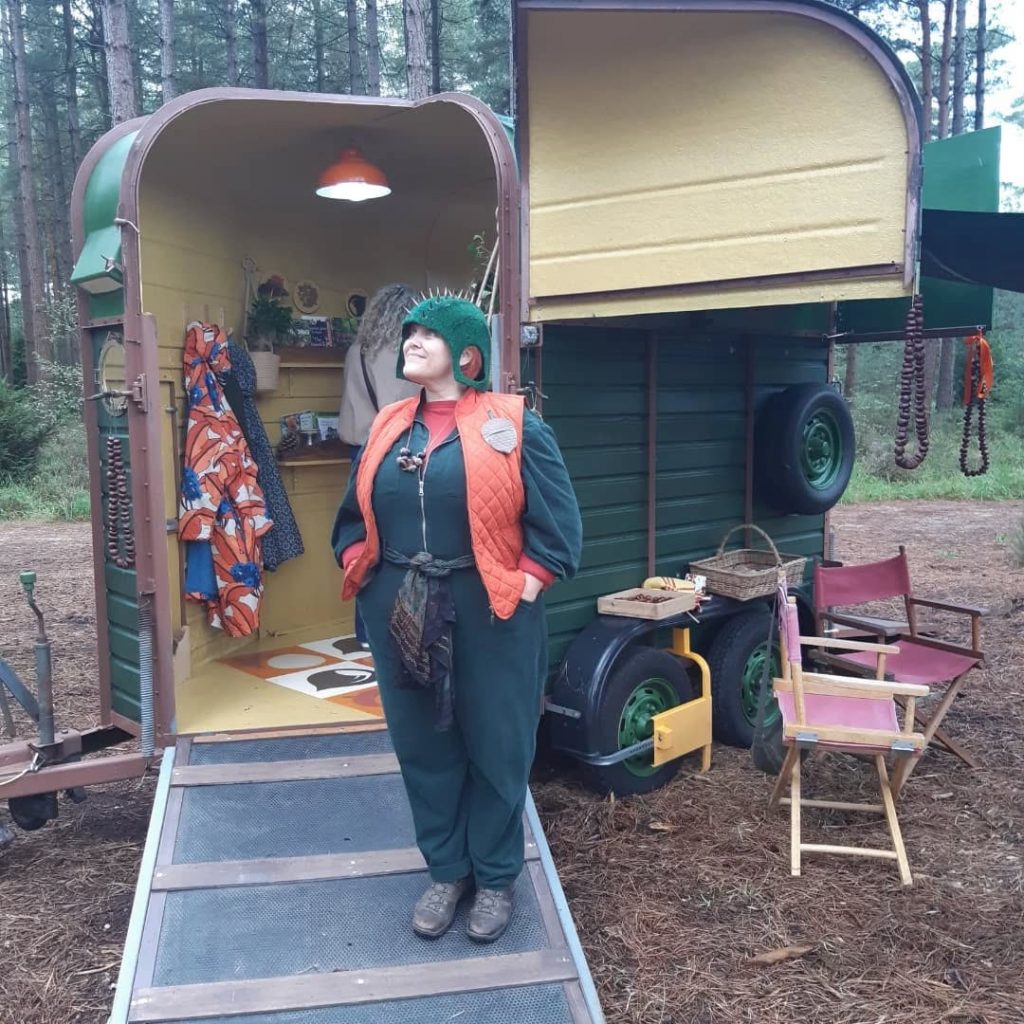
Our next stop is a hefty 70-minute drive away. We are off to Yeovil to see Becca Gill of environmental art collective Radical Ritual, here with their project Consequences.
Fascinated by the enduring mystery of the Cerne Abbas giant, Radical Ritual have created a vast temporary artwork, conjuring up a monumental new mythical creature. Consequences, a large-scale participatory project, draws on folk traditions, surrealist art-making, and collaborative storytelling ‘to create a new myth that reflects contemporary communities and their connection to the land’. The end result comprises the large-scale visual art piece, displayed on a hillside; together with workshops, parades, and a very lovely sound installation set alongside it.
‘I’m inspired by how myths shape our connection to place and to each other – how we have lost many of these connections, and how we might create new ones together,’ says Becca. ‘Consequences is an act of reclaiming belonging – to land, to shared histories, to each other – and is a symbol of what we can achieve when we embrace our differences and create together. I love that it is a great big game that breaks down the barriers to creating, that there is surprise in what others do, and that it taps into the subconscious at the same time as allowing people to co-create simultaneously.’
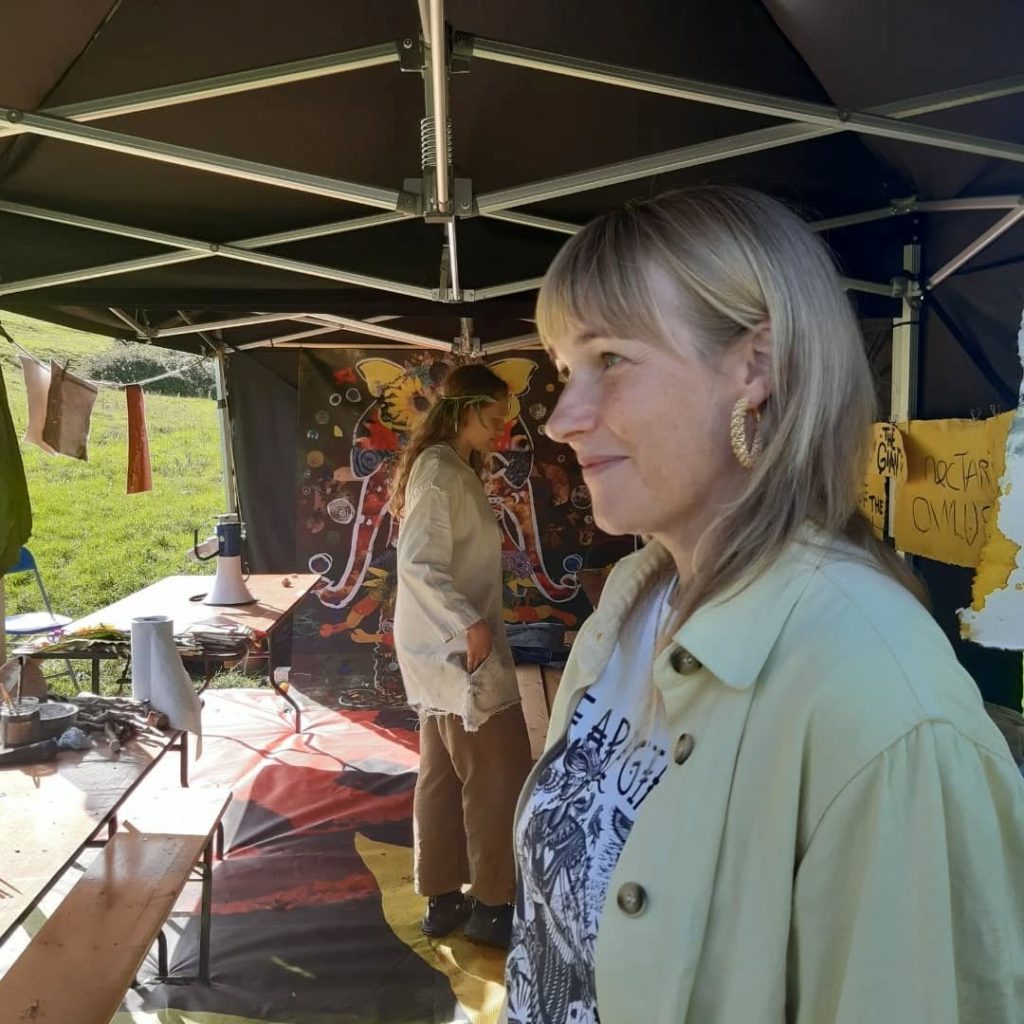
Now, geography is not my strongest subject, but even I know that Yeovil is in Somerset not Dorset – if only just over the border! But we are in Yeovil because it has played a key role in the development of the piece, as Becca explains:
‘Consequences started in conversation with Nick Hayes (Right to Roam) who was really inspired by the issue of access to land. We worked with over 200 people from Yeovil to create a new giant in Cerne Abbas, collecting plants to make inks and charcoal and pigments to create the body parts of the new giant. We worked with them in the landscape – played games of Consequences on a smaller scale, and then had a huge canvas outside which they could collage onto, working collectively and then individually to make their section. The flora and fauna you see in the giant is all from the hillside. They felt that they belonged in that landscape although none of them had ever been there before, even though they only lived 20 minutes down the road.’
The new Consequences giant made its first appearance alongside the legendary Cerne Giant, an ancient land art work depicting an enormous male figure carved on to the hillside. Now it has moved to Yeovil, giving locals a chance to see the artwork that was created in collaboration with members of their community.
So here we now are, on Summerhouse Hill above Yeovil. At the foot of the hill is the workshop tent, featuring a wonderful array of natural materials, from chalk to charcoal to wool and dyes made from local plants. There’s also a small orchard where the sound installation is sited. This has been created by Douglas Dare, and is a beautiful piece, merging folk instruments and electronics with a compelling spoken text full of witches’ lore that tells of houses where ox hearts studded with nails are found under the floorboards, and mummified cats are found bricked up behind the walls.
‘Douglas is an incredible musician who grew up near to the Cerne Giant in Dorset on a farm and when we first met we realised we both had a postcard of it on our fridges!’ says Becca. ‘His music is evocative and beautiful and I was keen to work with him. The soundtrack was created using found sounds from the hillside. He also incorporated the poem ‘This Patch of Land’ written by Louisa Adjoa Parker for Nature Calling, and we reached out to the people she interviewed when writing this so that their voices are featured in the composition.’
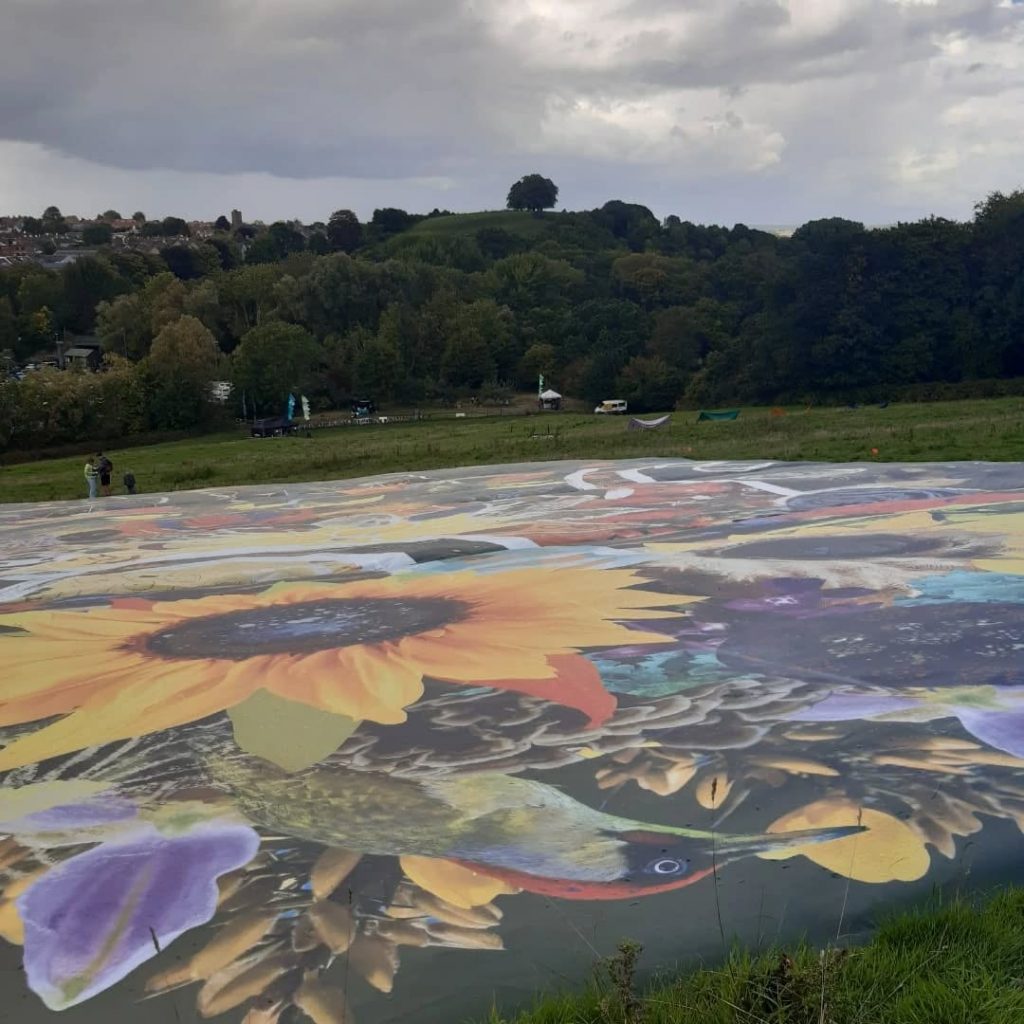
Moving on up the hill track: we can’t clearly see the whole piece from where we are, and thus trek right up the hillside, walking the circumference of the 30 x 40 metre ‘canvas’ (in fact, a specially constructed breathable material that, whilst being environmentally sound for the ground beneath it, can withstand the vagaries of the British weather). The images on it have been digitally created from the participants’ original drawings, using chalks coloured with inks and dyes taken from local plants.
We see heads, hands, torsos, legs and feet of very many different creatures, real and mythical. There are beady eyes and beaks, scales and wings and tails, in many different hues. Just as in the parlour game Consequences, each team working on their section didn’t get to see what others had drawn until the end reveal.
Becca tells me that Fairmead School for neurodiverse teenagers worked on the Head section. The Heart group was made with Global Majority, an organisation for refugees and asylum seekers. ‘Some of the kids wanted to paint the flags of their countries of origin and have these as petals at the centre of the heart, so we have Syrian and Palestinian flags at the heart centre,’ says Becca. The Legs were tasked to able2achieve: ‘a non-verbal boy took a stick and started to draw an elephant,’ says Becca. ‘We later discovered that there have been findings that show that elephants may have walked on this hillside in prehistoric times’. The Feet section was created by a group of local Year 4 primary school children, who loved mixing and creating with the paints and charcoal, enjoying how messy they got, and saying that they had only ever thought paint came from a plastic pot. One of the key elements of the project was making and using art materials created from the raw materials foraged from the local landscape.
‘I’ve been a long-time fan of ancient monuments, stone circles, chalk land art, and the ambiguity and power that these hold,’ says Becca. ‘I’m also a fan of the folklore around giants especially here in UK and the intangible pre-history which has been lost through many years of capitalism and colonialism. I’m excited by the resonance that these places hold and the imagination that they spark as we try to work out how and why they are there. This is an exciting starting point for working with many people to co-create new myths.’
Becca’s team of collaborators include the acclaimed author Sita Brahmachari and artist Grace Emily Manning, both of whom ran and continue to run the project workshops. They were also key to the parade that took place in Yeovil on the morning of Saturday 2o September. Sita had this to say about the parade:
‘On the day that there were marches seeding unrest and discord in our capital, I was proud to be part of a radical ritual here in Yeovil – a beautiful parade. The parade brought together people from each of the groups we had worked with. It was a gentle parade in keeping with the bright, beautiful, gentle new giant. What a joy to see the people of Yeovil with local and global roots and branches, from across generations, gather to see the giant they had helped to make. We held up our banners and sang. The sun shone as people living in the same town met – some for the first time, others reunited – and carried flags, making the sentence: ‘Together. We. Are. Giant.’
Leaving Yeovil, I take a train to Clapham Junction. As I cross the station, I’m moving through crowds of people wearing flags and waving flags – Union flags, the St George cross. There are beer cans thrown on the ground, and a lot of loud jeering. I remember that there has been a big far-right rally in London today, called Unite the Kingdom, organised by Tommy Robinson and addressed by Elon Musk.
I hurry on by, glad to have experienced a very different sort of flag flying at Inside Out Dorset.
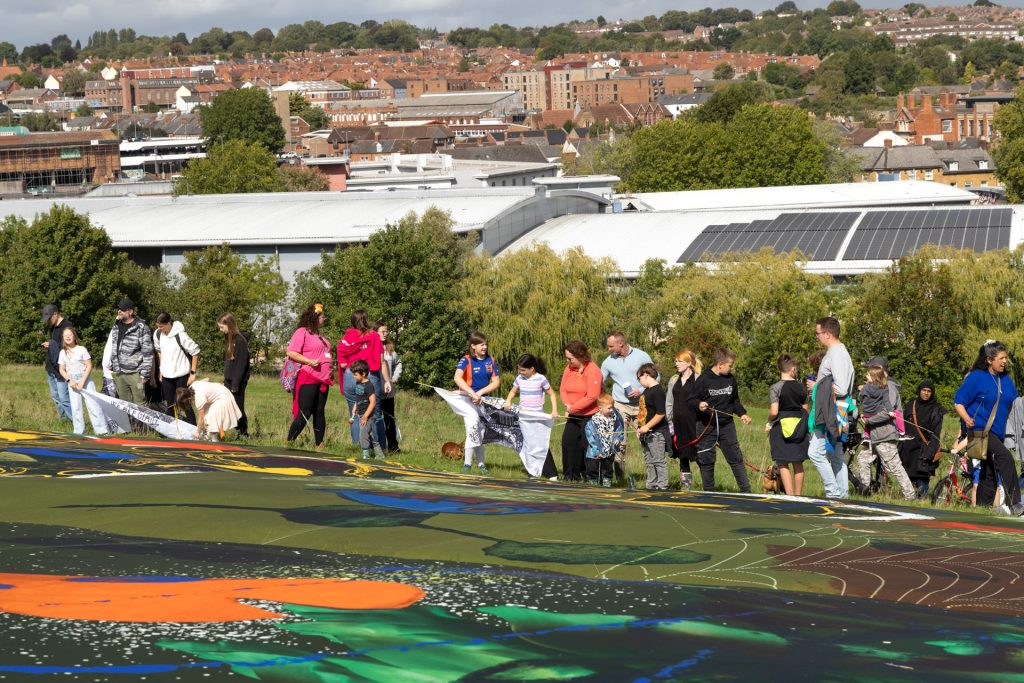
Featured image (top): Lorna Rees: Canopy. Photo Poppy Joy.
Dorothy Max Prior attended Inside Out Dorset 2025 on Friday 12th and Saturday 13th September as a guest of Activate and Martha Oakes PR.
The Inside Out 2025 programme ran Friday 12th to Sunday 21st September, with installations, artworks, performances and events across Dorset and into Somerset, with sites including Christchurch Quay, Forestry England’s Moors Valley Country Park and Forest, Corfe Castle, the beach in Weymouth, and Summerhouse Hill in Yeovil.
Inside Out Dorset is an international biennial outdoor arts festival. It presents live performance in unexpected places – in town centres, by the sea, in fields and in woodland – for everyone to enjoy. Some of Dorset’s most remarkable urban and rural spots are transformed with experiences that touch hearts and minds like nothing else. Inside Out Dorset is produced by Activate Performing Arts. www.insideoutdorset.co.uk
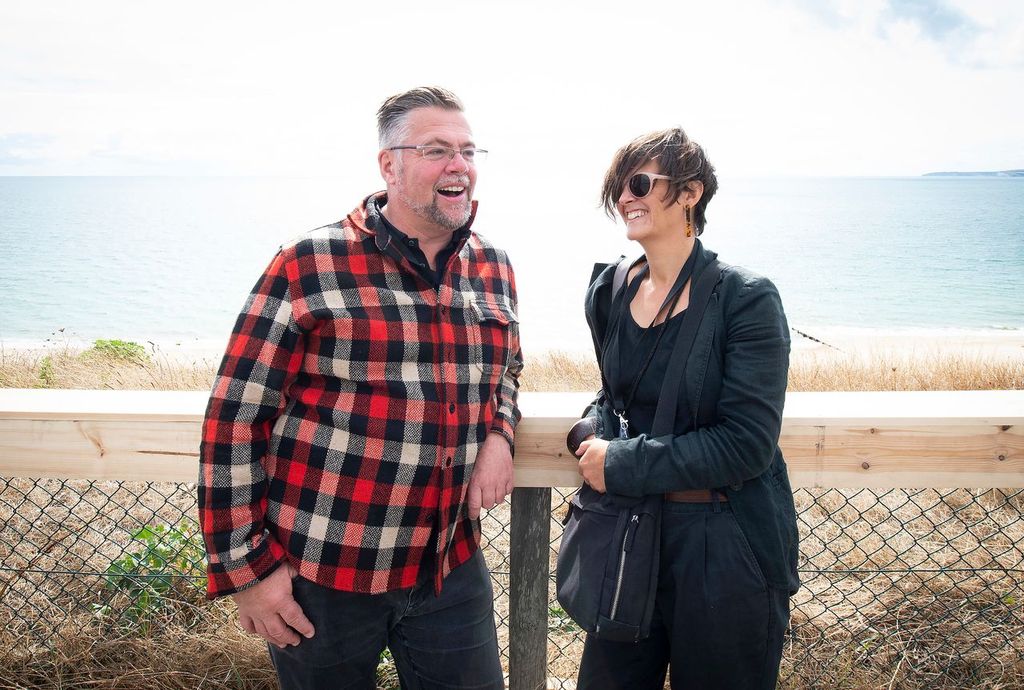
Activate exists to promote, support and produce performing arts projects in its communities. It brings world-class events to unexpected places, like town centres, village squares, beaches and hilltops. Supporting its performing arts community is at the heart of everything it does. It brings people together, offers advice, and provides access to learning and resources. It’s there to help creatives at all levels on their journey towards creating outstanding, inspiring work. As one of Arts Council England’s National Portfolio Organisations, it receives regular funding to initiate, develop and sustain a range of dance, theatre and outdoor arts opportunities for the people of Dorset and the South West. It is also core funded by Dorset Council and BCP Council. As a not-for-profit organisation, it works in many ways and with many partners. www.activateperformingarts.org.uk
Lorna Rees Company: Canopy: 24 ideas about trees was presented at Forestry England’s Moors Valley Country Park and Forest in Dorset, 13 to 21 September 2025, as part of Inside Out Festival. It was commissioned by The National Memorial Arboretum, Activate/Inside Out Dorset and Forestry England, with funding from Arts Council England National Lottery and Cultural Hub.

Radical Ritual: Consequences was presented in Yeovil 13–14 September and at Corfe Castle 20–21 September 2025 as part of Inside Out Festival. It was commissioned by Dorset National Landscape for the project Nature Calling, with executive producers the National Landscapes Association and Activate Performing Arts. It is supported by Arts Council England, Defra and Imaginators.
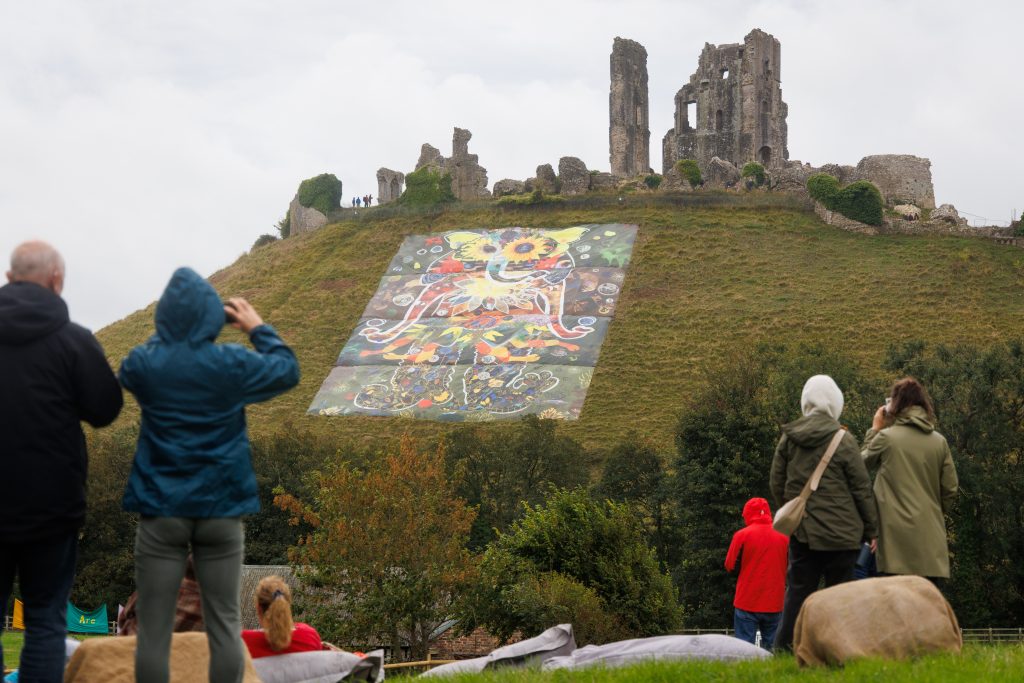
Thames Festival Trust with Heidi Stellar and Matt West: River of Hope was presented at Christchurch Quay 13–15 September 2025 as part of Inside Out Festival. It is delivered in partnership with Thames Festival Trust, and supported by Arts Council England (as part of the National Lottery Creative People and Places programme) and Paul Hamlyn Foundation.
